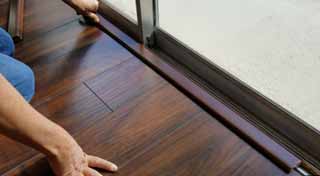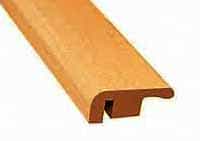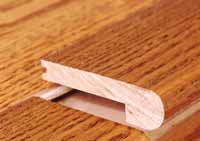Whether you purchase a new house or remodel it, your flooring needed to be smooth from one room to another. Nevertheless, different rooms have different flooring types. There is a type of transition strip for each of the different situations to connect your flooring in place. Laminate flooring transition is a standard solution.

Types of Flooring Transition
T-Molding

If you have two surfaces having similar levels, T-Molding will be necessary for installing the transition. The solution is also safe to keep the sub-floor on track because it has 94 inches long. Even if you have two or more hard floors to meet or connect with, T-Molding will become an appropriate approach.
Reducer

A reducer is a typical transition molding piece that is moved to one side. You can use reducers when two floors are not level with each other. Transition and installation tile projects need to apply reducers.
Stair Nose
Flooring transition in stair nosing is available on steps because you have to cover all edges to ensure that they are safe to walk on.
End Cap

An End Cap is utilized for carpet transition, laminate areas, and thresholds. This transition is also the molding type, which is safely retained on the subfloor.
Quarter Round
Quarter Round can be used in the wall base molding or separately to cover the surface gap, where enveloping transitions. The front of fireplaces or the plate of steps and cabinets are also needed to use Quarter Round. The look of finalization in the Quarter Round makes your transitions more tremendous.
How to Do the Transition
To install a transition, many processes are depending on the place and product. The method of change is also various. The good news is that you can follow some necessary steps to put transition areas. The first thing you have to do is prepare the apparatus.
Prepared Tools
- Hammer drills
- ¼-inch masonry drill bit
- ¼-inch dowel
- A screw gun or a screwdriver
- Tin snips
- Plastic inserts
- A pencil
- The tape measure
- A flooring cutting tool
6 Simple Steps to Install
Step 1: Cut the Mold Sample
The transition moldings often have a track that should be repaired to the floor initially. If your subfloor gets the mold, it will be easy to put the track. It would help if you cut the mold sample before installing it on the surface. You can take the help of a miter saw to cut the molding.
Step 2: Install the Mold Sample to the Frame
Please note that the molding placement must be taken into account before installing the sample to the frame.
For example, you want to put the molding in the right position (under the doorway) when closing the door. If a carpet stays outside of the room (where the transition is), the carpet will be stopped at the door. It will not prevent the door in its way.
Step 3: Make Marks to Identify the Right Position
How could you know the right place to put the sample in the frame? It would help if you made many marks on the frame or the flat before adding the mold sample. The tab from the T-mold, for instance, secures the track in the bottom part of the mold.
Step 4: Begin with the Installation of the Tracks
After adding the mold samples, this is the time to install the tracks on a suitable underlayment to the transition line. You could drill the screws and use dowels to the holes. If you need to cut the track, you will need to estimate the width of the frame of the doorway.
Step 5: Insert the Dowel into the Hole
When installing the tracks and drilling holes on the surface, you ought to put the dowel into the holes. Use a hammer to snap the hold off at the bottom. Pay attention to the concrete because of sticking up. If it happens, solve the problem with a screwdriver or a chisel.
Step 6: Secure the Tracks
The tracks could be falling, so you need to keep them in place with wood screws. Using a 3/4-inch screw is a good option.
When should You do the Flooring Transition?
Transit between Similar Materials on the Surface
If you are going to change one type of flooring to a similar kind, it will be accessible to make a transition strip. Using the laminate flooring transition could be the right choice.
Transit Two Different Floor Coverings

A transition strip is necessary for this situation. You can choose the transition even if the surface is not wood. Laminate flooring allows the surface to become laminate floors.
Transition Mistakes in the Floating Floor Project
Glue or Nail Transition Strips
Gluing or nailing between the floating floor and the subfloor is a widespread transition mistake. This is because flooring floors are enlarged and connected without control; they do not fix any object. Nail or glue the trim to the floors may lead to a big gap between planks or buckling if an extension happens.
Put the Quarter Round into the Floating Floor
Inserting the quarter round into the floating floor is also a common mistake. The floor and subfloor cannot move smoothly and causing a pinch point. Gapping, end-joint peaking, and buckling may occur at any time.
Install the Floor Too Tight or Too Wide
Floating floors often demand an increasing gap around fixed objects. Fixed objects could be walls, pipes, and transitions. Due to the climate, floating floors will change your house’s interior. Therefore, if you install the floor is too tight in a place like a bathroom or a kitchen, the expansion gap will be more significant.
Not Getting a Great Bond with the Adhesive
The adhesive is not compatible with the transition molding and the surface might not have a good bond. The dirty surfaces and old adhesive also have a weak bond. In some situations, weight is an incredible solution to keep the adhesive in place.
Install Flush Transitions in Floating Floors

Flush transitions are widespread ways to nail or glue down wood floors. In general, floating floors require unique transition moldings, which are over-lap ones.
They probably transit from one floor to another while holding an expansion gap. So, the surface may have flexible contact with climate changes in the room or house.
Adding a floating floor to a flush transition molding can cause end-joint peaking and squeaks.
Laminate Flooring Transition to the Door Threshold
Transit the laminate floor to the door threshold is essential for the entire house interior. You should know where to end the laminate transition to make your house more beautiful. For example, carpets could not spread from one room to another when the door is closed. The flooring transition, in this case, can hide the carpet side.
Laminate Flooring Transition between Rooms
To do the transition between rooms, you should make an installation plan covering the whole floor. Problems may happen in the middle time of the job.
Before kicking off, determine the suitable direction to run the flooring and transition way. When getting a plan, your installation will be straightforward and time-saving.
You should select the most fantastic position to transit the laminate floor. Then, you use the transition strips and lay them on the surface.
Laminate Floor Transitions Doorway
A laminate floor transition doorway is an excellent idea to change from one flooring to another in doorways. Nonetheless, it would help if you made a transition strip to keep the border in place between them. If they have different thicknesses, the transition strip could be reduced people from getting their toes on the high sides.
Bottom line
Install the transition is quite difficult for those who do not know what to do with hundreds of pieces. This is the reason I make this guide for you to do it by yourself. You have a general background about the flooring transition and identify how to undertake laminate projects.
We covered your beneficiary similar stuff here-
